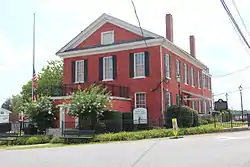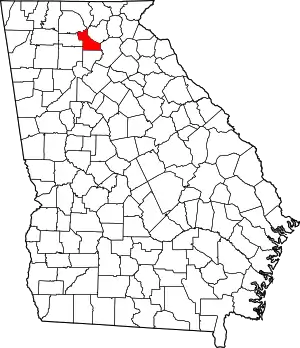Dawsonville, Georgia | |
|---|---|
 Historic Dawson County Courthouse | |
 Flag  Seal | |
| Motto(s): "Protecting our history and providing for the future" | |
 Location in Dawson County and the state of Georgia | |
| Coordinates: 34°25′N 84°7′W / 34.417°N 84.117°W | |
| Country | United States |
| State | Georgia |
| County | Dawson |
| Area | |
| • Total | 8.61 sq mi (22.31 km2) |
| • Land | 8.59 sq mi (22.25 km2) |
| • Water | 0.02 sq mi (0.06 km2) |
| Elevation | 1,365 ft (416 m) |
| Population (2020) | |
| • Total | 3,720 |
| • Density | 433.01/sq mi (167.19/km2) |
| Time zone | UTC-5 (Eastern (EST)) |
| • Summer (DST) | UTC-4 (EDT) |
| ZIP code | 30534 |
| Area code | 706 |
| FIPS code | 13-21940[2] |
| GNIS feature ID | 0331529[3] |
| Website | www |
Dawsonville is a city in and the county seat of Dawson County,[4] Georgia, United States. The population was 2,536 at the 2010 census,[5] up from 619 in 2000.
Dawsonville is included in the Atlanta-Sandy Springs-Roswell, GA Metropolitan Statistical Area.
History
Dawsonville was founded in 1857 as seat of the newly formed Dawson County. It was incorporated as a town in 1859 and as a city in 1952.[6] The community and the county are named for state senator William Crosby Dawson.[7]
Geography
Dawsonville is located at 34°25′N 84°7′W.
According to the United States Census Bureau, the city has a total area of 8.2 square miles (21.3 km2), of which 0.02 square miles (0.05 km2), or 0.26%, is water.[5]
The community is at the junction of State Routes 9, 53, and 136. SR 9 leads northeast 14 miles (23 km) to Dahlonega and south 17 miles (27 km) to Cumming, while SR 53 leads southeast 6 miles (10 km) to U.S. Route 19 and west 24 miles (39 km) to Jasper. SR 136 also leads to Jasper, on a 29-mile (47 km) route that runs further to the north through the southern end of the Blue Ridge Mountains.
Amicalola Falls, 15 miles (24 km) north of the center of Dawsonville, is one of the seven natural wonders of Georgia.
Demographics
| Census | Pop. | Note | %± |
|---|---|---|---|
| 1880 | 199 | — | |
| 1900 | 217 | — | |
| 1910 | 179 | −17.5% | |
| 1920 | 198 | 10.6% | |
| 1930 | 203 | 2.5% | |
| 1940 | 319 | 57.1% | |
| 1950 | 318 | −0.3% | |
| 1960 | 307 | −3.5% | |
| 1970 | 288 | −6.2% | |
| 1980 | 342 | 18.8% | |
| 1990 | 467 | 36.5% | |
| 2000 | 619 | 32.5% | |
| 2010 | 2,536 | 309.7% | |
| 2020 | 3,720 | 46.7% | |
| U.S. Decennial Census[8] | |||
2020 census
| Race | Num. | Perc. |
|---|---|---|
| White (non-Hispanic) | 3,236 | 86.99% |
| Black or African American (non-Hispanic) | 29 | 0.78% |
| Native American | 15 | 0.4% |
| Asian | 20 | 0.54% |
| Pacific Islander | 5 | 0.13% |
| Other/mixed | 167 | 4.49% |
| Hispanic or Latino | 248 | 6.67% |
As of the 2020 United States census, there were 3,720 people, 998 households, and 667 families residing in the city.
2000 census
As of the census[2] of 2000, there were 619 people, 234 households, and 153 families residing in the city. The population density was 320.9 inhabitants per square mile (123.9/km2). There were 257 housing units at an average density of 133.2 per square mile (51.4/km2). The racial makeup of the city was 97.58% White, 0.16% Native American, 0.97% from other races, and 0.65% from two or more races. Hispanic or Latino people of any race were 3.00% of the population.
There were 234 households, out of which 31.2% had children under the age of 18 living with them, 44.0% were married couples living together, 15.8% had a female householder with no husband present, and 34.6% were non-families. 29.9% of all households were made up of individuals, and 9.4% had someone living alone who was 65 years of age or older. The average household size was 2.31 and the average family size was 2.88.
In the city, the population was spread out, with 22.8% under the age of 18, 12.4% from 18 to 24, 31.5% from 25 to 44, 22.0% from 45 to 64, and 11.3% who were 65 years of age or older. The median age was 34 years. For every 100 females, there were 114.2 males. For every 100 females age 18 and over, there were 117.3 males.
The median income for a household in the city was $34,327, and the median income for a family was $39,000. Males had a median income of $27,500 versus $25,125 for females. The per capita income for the city was $20,207. About 12.3% of families and 11.9% of the population were below the poverty line, including 13.3% of those under age 18 and 15.7% of those age 65 or over.
Recreation
Auto racing

The city's community is known in auto racing circles for its long tradition of involvement in the sport; many racing skills originally developed as a consequence of moonshine activity in the area. Dawsonville celebrates this legacy each October with the annual "Mountain Moonshine Festival".[10]
Dawsonville is the home of retired NASCAR driver Bill Elliott, who won the Winston Cup championship in 1988 and was inducted into the NASCAR Hall of Fame in 2015, and his son Chase Elliott, who won the 2020 NASCAR Cup Championship and who currently races in the NASCAR Cup Series. Bill Elliott's nickname is "Awesome Bill from Dawsonville".[11] The former city hall has a racing theme as well, and serves as the location of the Georgia Racing Hall of Fame. Following a significant racing accomplishment made by Bill or Chase Elliott, such as a win, the siren on the Dawsonville Pool Room near the city square goes off to let the town know.
Education
Dawson County School District
The Dawson County School District holds pre-school to grade twelve, and consists of three elementary schools, two middle schools, and a high school.[12] The district has 219 full-time teachers and 3,036 students.[13]
- Black's Mill Elementary School
- Kilough Elementary School
- Robinson Elementary School
- Riverview Elementary School
- Dawson County Middle School
- Dawson County Junior High School
- Dawson County High School
The Dawson County School System is a charter system.
Notable people
- Spencer Davis; stock car driver
- Casey Elliott; stock car driver and nephew of Bill Elliott
- Chase Elliott; stock car driver and son of Bill Elliott
- Bill Elliott, or "Awesome Bill from Dawsonville"; stock car driver
- Jerry Glanville; National Football League head coach, and NASCAR driver
- Bill Goldberg; professional wrestler and actor; once resided in Dawsonville
- Roy Hall; moonshine runner and early stock car racing driver, cousin of Lloyd Seay
- Corey Johnson; professional male runway model, actor, producer
- Raymond Parks; moonshine runner and NASCAR pioneer regarded as the first "team" owner in stock car racing, a relative of Seay and Hall
- Lloyd Seay; moonshine runner and early stock car racing driver, cousin of Roy Hall
- David Sosebee; race car driver
- Gober Sosebee; race car driver
References
- ↑ "2020 U.S. Gazetteer Files". United States Census Bureau. Retrieved December 18, 2021.
- 1 2 "U.S. Census website". United States Census Bureau. Retrieved January 31, 2008.
- ↑ "US Board on Geographic Names". United States Geological Survey. October 25, 2007. Retrieved January 31, 2008.
- ↑ "Find a County". National Association of Counties. Archived from the original on May 31, 2011. Retrieved June 7, 2011.
- 1 2 "Geographic Identifiers: 2010 Demographic Profile Data (G001): Dawsonville city, Georgia". U.S. Census Bureau, American Factfinder. Retrieved October 20, 2015.
- ↑ Hellmann, Paul T. (May 13, 2013). Historical Gazetteer of the United States. Routledge. p. 227. ISBN 978-1135948597. Retrieved November 30, 2013.
- ↑ Gannett, Henry (1905). The Origin of Certain Place Names in the United States. Govt. Print. Off. pp. 101.
- ↑ "Census of Population and Housing". Census.gov. Retrieved June 4, 2015.
- ↑ "Explore Census Data". data.census.gov. Retrieved December 14, 2021.
- ↑ "Welcome to Dawsonville Georgia".
- ↑ Mike Hembree (April 23, 2014). "Bill Elliott's son Chase making his own name in NASCAR". USA Today. Retrieved May 4, 2018.
- ↑ Georgia Board of Education, Retrieved June 8, 2010.
- ↑ School Stats, Retrieved June 8, 2010.
